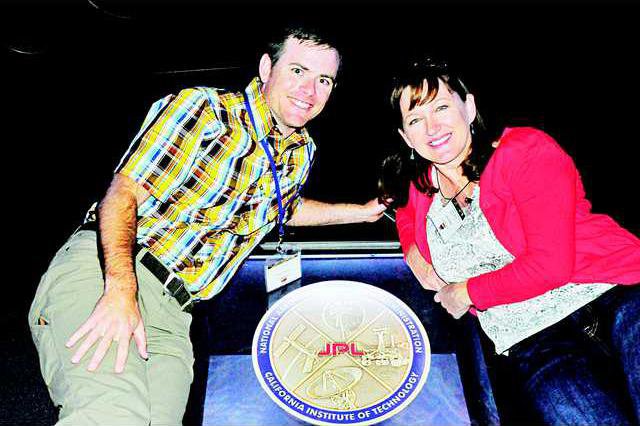Two Turlock science teachers, who happen to be husband and wife, were given an ‘out-of-this-world’ opportunity after being invited to attend a NASA-sponsored program that the two will not soon forget.
Ryan and Laura Hollister both teach for the Turlock Unified School District, with Laura teaching geoscience at Pitman High School, while Ryan teaches geoscience and AP environmental science at Turlock High School. In 2012, the two were invited to attend the NASA Triad project at Arizona State University after stumbling across an application for the program via social media website Twitter.
“After reading the post, Laura and I got so excited about participating that we immediately updated our resumes, wrote and sent our letters of intent that night,” said Ryan. “Several nail-biting weeks passed before we finally learned of our acceptance into the program, and as it turned out, we were the only teachers from California who had been accepted.”
After spending a week touring science facilities at ASU, including a meteorite lab with over $250 million worth of specimens and the Mars Space Flight Facility, and learning alongside research scientists who are actively involved in advancing knowledge of the moon, the two returned home with a myriad of new knowledge. The couple was also tasked with creating several grants, lesson plans and teacher trainings that incorporated their new knowledge at the conclusion of the 2012 conference.
Then in 2013, the couple was asked to attend the special 2013 NASA Jet Propulsion Lab edition of the NASA Triad project.
“I believe that our passion for the subject matter shone through in our resulting products, thus we were asked to attend the 2013 JPL edition of the NASA Triad project,” said Ryan. “We had the honor of being one of the 30 teachers out of 100 from other Triad cohorts across the country to be selected for the 2013 JPL conference.”
Running in the beginning of August, the JPL experience took the teaching duo immediately into the NextGen Science and Common Core Standards, explaining how they will help shape science education for the better. The larger purpose of the trip, Ryan says, was to spend professional development time at the Jet Propulsion Lab.
“We received the latest and greatest NASA-made lessons for the ‘Curiosity in your Classroom’ project along with the ‘nerdrenaline’ rush of an all-access tour of the Mars Yard,” said Ryan. “The Mars Yard is where we got to meet the Curiosity rover’s doppelganger that is used to test performance commands on a simulated mars surface before being uploaded to the actual rover on Mars.”
Participants also had the unique opportunity to meet with actual Curiosity mission specialists, who presented the teachers with images and data that have not yet hit publication.
“Their firsthand accounts of the scientific compromises needed to go from concept to reality in eight years were amazing,” said Ryan. “While we were at the FCC, we were privileged to witness one Curiosity team member uploading the days instructions to Mars to be received by the rover about 20 minutes later after the radio commands traveled the nearly 220 million miles to Mars at the speed of light.”
The couple was introduced to Dr. Justin Maki, an imaging systems specialist with NASA who has designed and built every single camera on each Mars landing mission since 1997.
Following the JPL experience in August, the couple returned to their own classrooms at Turlock and Pitman High Schools with a wealth of knowledge to share with their students.
“We definitely got to share some really neat photos and stories to start off the year,” said Ryan. “The promise of doing student-based, authentic research using cutting-edge NASA materials throughout the year got some kids really jazzed. We came home with a fat binder of ready-to-use Mars related labs for all grade levels that were already articulated to the NextGen and Common Core Standards. Most will be implemented at various times throughout the year.”
Among the projects is the Mars Student Imaging Project which allows students to analyze and decipher surface photos of Mars to determine its geologic history. Students who participate in the project are encouraged to join the MISP club being piloted by Laura at Pitman High School.
“In the bigger picture, our adventure to NASA JPL helps to lend credibility to our subject matter and gives us a concrete example to share with our students of the lengths to which Laura and I go stay at the forefront of geosciences information for our students,” said Ryan. “I think the students see that we work extremely hard for them and they pay us back by working hard for us. In return, we’ve created better informed citizens that will one day help solve the many great geoscience problems in the Central Valley.”





